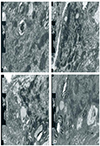1. Qiu W, Zheng L, Gu H, Chen D, Chen Y. Comparison between adult and infant lung injury in a rabbit ischemia-reperfusion mode. J Thorac Cardiovasc Surg. 2008; 136:352–359.
2. Kim JC, Shim JK, Lee S, Yoo YC, Yang SY, Kwak YL. Effect of combined remote ischemic preconditioning and postconditioning on pulmonary function in valvular heart surgery. Chest. 2012; 142:467–475.
3. Rong J, Ye S, Liang MY, et al. Receptor for advanced glycation end products involved in lung ischemia reperfusion injury in cardiopulmonary bypass attenuated by controlled oxygen reperfusion in a canine model. ASAIO J. 2013; 59:302–308.
4. Rong J, Ye S, Wu ZK, et al. Controlled oxygen reperfusion protects the lung against early ischemia-reperfusion injury in cardiopulmonary bypasses by downregulating high mobility group box 1. Exp Lung Res. 2012; 38:183–191.
5. Wang C, Li D, Qian Y, Wang J, Jing H. Increased matrix metalloproteinase-9 activity and mRNA expression in lung injury following cardiopulmonary bypass. Lab Invest. 2012; 92:910–916.
6. Qi D, Gao MX, Yu Y. Intratracheal antitumor necrosis factor-α antibody attenuates lung tissue damage following cardiopulmonary bypass. Artif Organs. 2013; 37:142–149.
7. Maniatis NA, Kardara M, Hecimovich D, et al. Role of caveolin-1 expression in the pathogenesis of pulmonary edema in ventilator-induced lung injury. Pulm Circ. 2012; 2:452–460.
8. Radovits T, Beller CJ, Groves JT, et al. Effects of FP15, a peroxynitrite decomposition catalyst on cardiac and pulmonary function after cardiopulmonary bypass. Eur J Cardiothorac Surg. 2012; 41:391–396.
9. Gecit I, Kavak S, Yüksel MB, et al. Effect of short-term treatment with levosimendan on oxidative stress in renal tissues of rats. Toxicol Ind Health. 2014; 30:47–51.
10. Paraskevaidis IA, Parissis JT, Kremastinos D. Anti-inflammatory and anti-apoptotic effects of levosimendan in decompensated heart failure: a novel mechanism of drug-induced improvement in contractile performance of the failing heart. Curr Med Chem Cardiovasc Hematol Agents. 2005; 3:243–247.
11. Markou T, Makridou Z, Galatou E, Lazou A. Multiple signalling pathways underlie the protective effect of levosimendan in cardiac myocytes. Eur J Pharmacol. 2011; 667:298–305.
12. Caimmi PP, Molinari C, Uberti F, et al. Intracoronary levosimendan prevents myocardial ischemic damages and activates survival signaling through ATP-sensitive potassium channel and nitric oxide. Eur J Cardiothorac Surg. 2011; 39:e59–e67.
13. Hönisch A, Theuring N, Ebner B, Waqner C, Strasser RH, Weinbrenner C. Postconditioning with levosimendan reduces the infarct size involving the PI3K pathway and KATP-channel activation but is independent of PDE-III inhibition. Basic Res Cardiol. 2010; 105:155–167.
14. Ozturk T, Gok S, Nese N. Levosimendan attenuates reperfusion injury in an isolated perfused rat heart model. J Cardiothorac Vasc Anesth. 2010; 24:624–628.









 PDF
PDF ePub
ePub Citation
Citation Print
Print


 XML Download
XML Download